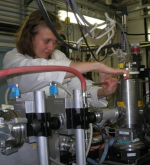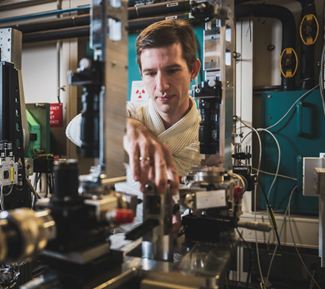ESRF members
 |
E. Bazarkina (CRG BM20/BM16/BM30) I am studying the solubility of minerals and the state of dissolved metals in aqueous solutions under conditions appearing in the crust and upper mantle (up to 500°C and 2000 bar). The ultimate goal is to identify the geochemical conditions required to form hydrothermal ore deposits (i.e. when the highest metal concentrations in fluids can be riched), compare metal behaviors, and constrain the geochemical tracers of natural processes. |
|
|
Benoit Cordonnier (Visiting Scientist at ID19) Volcanologist, I relentlessly explored Earth gears and clockwork. I specialized myself in experimental geology, mimicking natural processes and observing what is normally hidden by millions of years or kilometers of depth. Academic and proud tech-nerd, I always look for new approaches to make progress our understanding in rock mechanics. It naturally pushed me to settle at the European synchrotron (ESRF), this unparalleled laboratory. |
|
|
Kathleen Dollman (Post-Doc at BM18) I always have been fascinated by all things ancient, and I became hooked on ancient, fossilized animals when I visited the Evolutionary Studies Institute, Johannesburg. My research focus is on the ancestors of crocodiles, the very earliest members of this once large and very diverse group of animals.The synchrotron light source allows us to see inside fossils with unprecedented detail, and I am excited to investigate the ecology and biology of many different groups of animals with this amazing technological resource. I did my undergraduate studies at the University of the Free State (South Africa), and my postgraduate studies at the Evolutionary Studies Institute, University of Witwatersrand (South Africa). |
|
|
Angelika Dorothea Rosa (Scientist at ID24-DCM/BM23/ID15b) I am an experimental mineralogist and geochemist, my primary objective is a better comprehension of global element cycles and geodynamical processes taking place in the deep Earth’s interior. I am particularly interested in understanding the underlying microscopic mechanisms that are at the origin of global scale phenomena. I have a long-standing experience in experimental mineralogy that enabled me extracting fundamental physico-chemical properties of geomaterials at the relevant extreme P/T conditions of the Earth’s interior (>130 GPa, > 4000 K) using state-of-the-art in-situ methods and synchrotron X-ray radiation. |
|
|
Harald Müller (Chemistry Lab Manager) Chemistry & Micro-Imaging Chemist, with a strong preparative background and a long experience in the field. The Local Mineralogy Project: Initially a purely private initiative, collecting minerals in the Isère department has gradually evolved over the last ten years from a pastime activity into a more systematic search and identification of (local) and (occasionally hitherto unknown) mineral specimen. The expertise and active involvement of ESRF staff scientists (W. Crichton, M. Hanfland) and visitors (M. Merlini) as well as the characterization resources offered by the ESRF have been invaluable. Since the early beginnings in 2005, this activity has been extended and includes also field trips and collecting opportunities outside of the initial area. |
|
|
Jean-Alexis Hernandez (Junior Scientist at ID24-HPLF) At the intersection between mineralogy, shock and plasma physics, I am studying minerals and liquid phases presenting an interest for the understanding of the deep early Earth, super-Earths and water-rich exoplanets. In order to reproduce the extreme conditions typical of these planetary interiors (up to several hundred GPa and thousands of Kelvin), I combine high-pressure experiments and atomistic simulations. In particular, I use and develop laser-driven dynamic compressions (on- and off-Hugoniot) coupled or not with ultrafast X-ray diffraction, and soon X-ray absorption spectroscopy on ID24-ED with the High Power Laser Facility. |
|
|
Ilya Kupenko (Scientist at ID14) I am a mineral physicist studying the chemical and physical properties of geophysically important materials at extreme conditions. I am currently mostly focused on the investigation of magnetic materials in the mantle and on constraining the composition of the Earth’s core. Our mantle might be not as magnetically ‘dead’ as it is usually assumed, so I am studying the magnetic minerals at mantle conditions by Synchrotron Mössbauer Source spectroscopy at ID14. For the core, I am investigating the elasticity and plastic deformation mechanisms of candidate binary and ternary iron alloys and compounds in situ at high pressures and temperatures using a combination of state-of-art synchrotron techniques: Nuclear Inelastic Scattering at ID14, Inelastic X-ray scattering experiments at ID28, and X-Ray Diffraction at ID15b and ID27 beamlines. |




